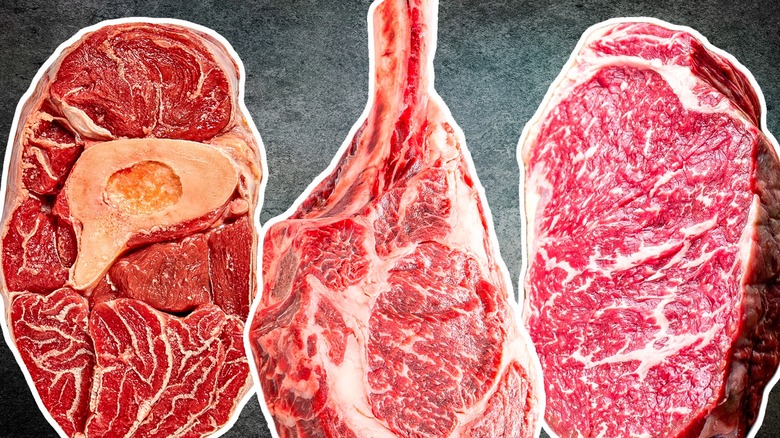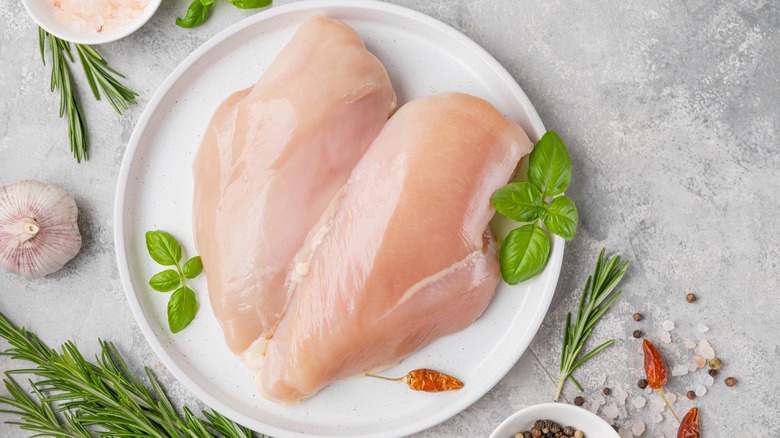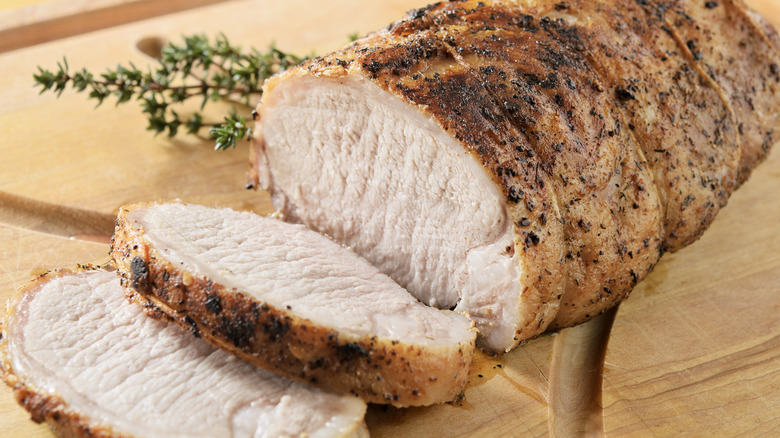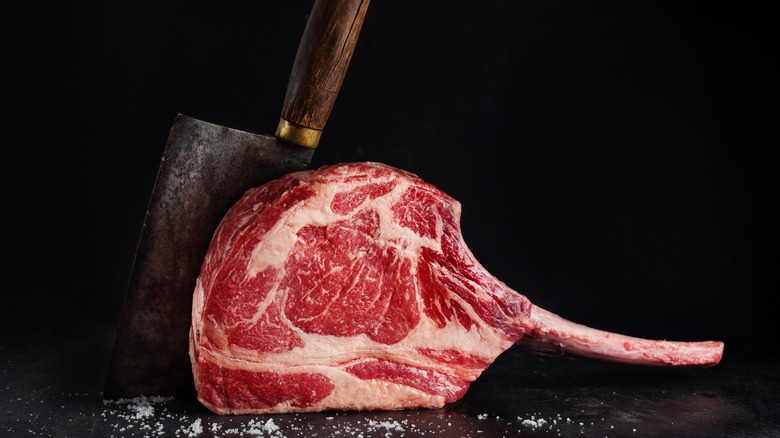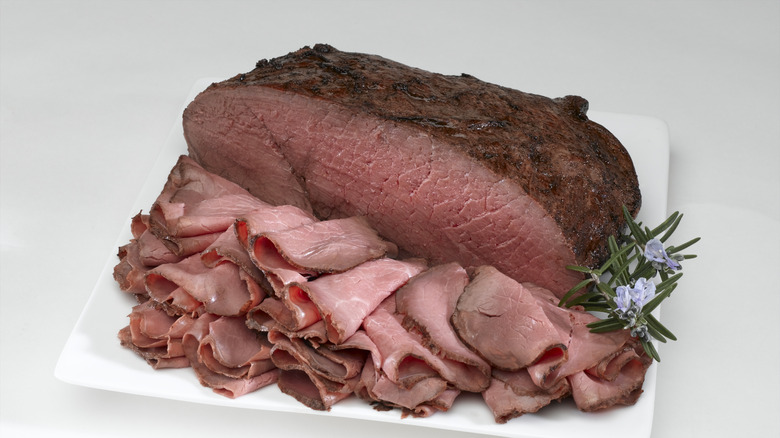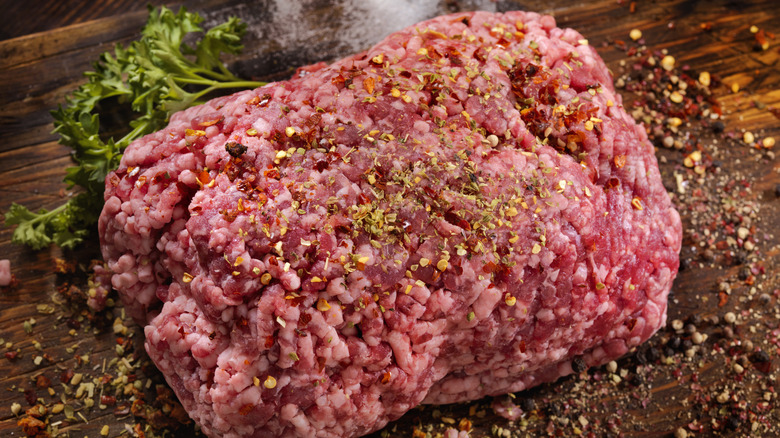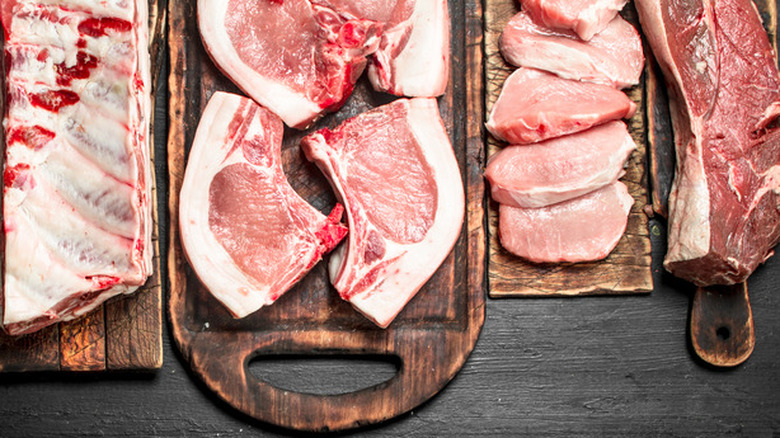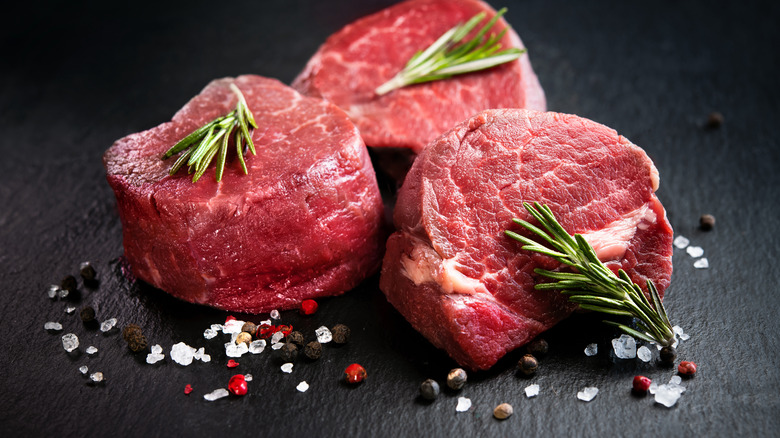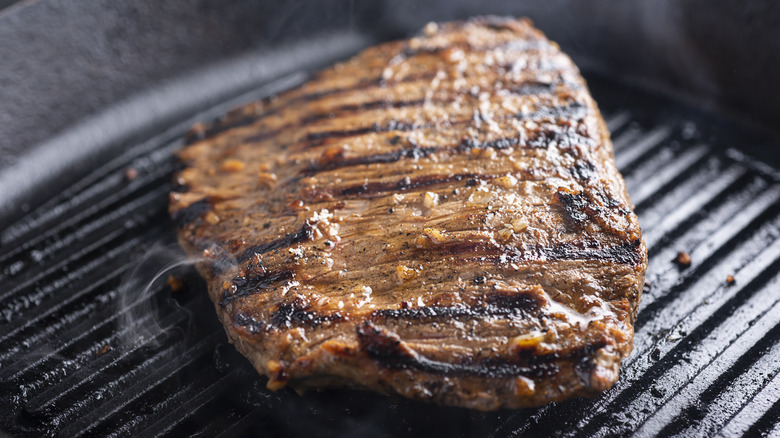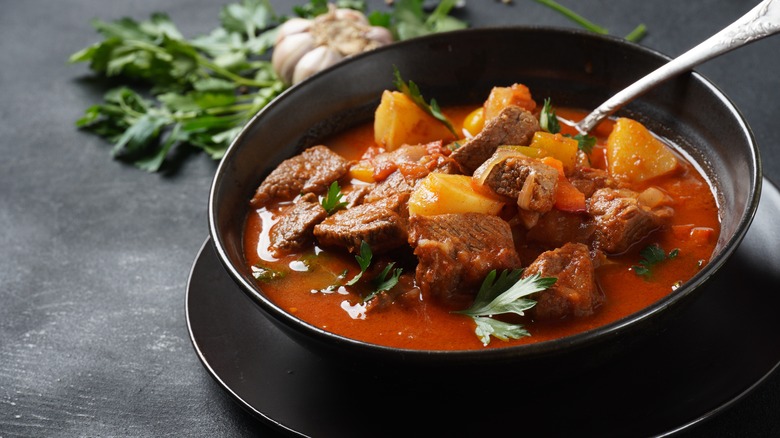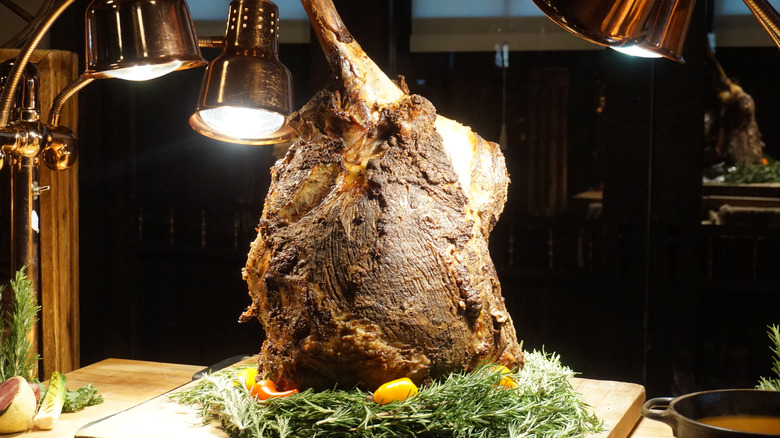10 Worst-Value Cuts Of Meat You Can Buy
Most grocery store meat sections are pretty bland and include the same lean cuts of pork, chicken, beef, and sometimes lamb. But prices can vary wildly depending where on an animal a particular steak, roast, or rib derives from. What makes a cut of meat valuable or not so much? Is it how many likes it gets on Instagram? How versatile is it as a mattress food waiting to be covered in condiments? Or does the flavor and fat content make the purists say, "Leave it be?" Value is in the eye of the beholder, but for this consideration, it also comes down to flavor, cost, and the amount of effort a certain cut requires to cook.
A piece of meat isn't good just because it's expensive. Adversely, cheap meats are not dispensable. Some of the most delicious cuisines use inexpensive cuts of meat once disregarded by wealthy and elite cultures in creative and cherished preparations. Let's face it; nothing is valuable anyway if it's not prepared correctly. A $50 steak can still get burnt. With that in mind, there are a few questionable types of meat that can be considered worst-value cuts.
Chicken breast
Chicken. Is. Loved. Whether fried, broiled, grilled, or baked, it's a favorite food. Unfortunately, chicken breast, in particular, can be extremely boring and is potentially one of the least flavorful poultry cuts. The popularity of chicken breast still lingers from the days of high-protein meal trends. But, as it turns out, fat gives meat flavor, and without it, there needs to be more seasoning. This makes chicken breast the tofu of chicken meat.
Chicken is accessible and available at every store, and because of its flat shape, the breast can be cooked quickly on a stovetop. But, every cook has had that moment where it's been salted, peppered, and thrown in the oven only to become a dry devastation. Without marination or brine, there is little hope. Leaner meats like this are a worst-value cut because the lack of fat costs in flavor. Of course, there are ways to cook chicken breast better if you have the time and effort to try something different. A quality chicken breast recipe can have you serving up a worthwhile orange-chicken stir-fry or exciting pecan-crust dinner.
Pork tenderloin
Pork tenderloin is in the worst-value category for a similar reason as chicken breast. It's lean and often dry. Not a very sexy dish, especially when left without sauce. Pork often pairs well with a sweet topping or can benefit immensely from a marinate. This cut is lean enough to forget that you're eating pork, and what's the fun of that? If you're going to indulge, why not choose something full of flavor?
If you want to try to flavor up this decidedly basic cut, try a not-boring pork tenderloin recipe, which gives what is referred to as a "Tuscan treatment" to your tenderloin. This recipe will enhance its (few) natural juices with a mix of rosemary, sage, and garlic. Try slicing the tenderloin into medallions before cooking quickly on high heat so more surface area can be browned with a sweet flavor from the caramelized garlic without overcooking the inside to a dry mouthful.
Regardless of the effort it takes to cook, tenderloin remains a favorite for serving large groups of people at barbecues or house gatherings. It can feed gatherings because it comes in a cylindrical cut between one and two pounds, which is easy to slice into a perfect serving size while resting on top of some mashed potatoes or greens. Cost considered, pork tenderloin isn't as overpriced as other worst-value cuts; unless your time is money, then you should aim for something that can shine on its own.
Tomahawk steak
It may be a surprise that the tomahawk steak is on our list of the worst-value cuts because the cut itself isn't inferior. It can be quite a high-quality steak to sear and broil for an even, rich flavor. Essentially a ribeye, the infamous tomahawk cut comes with an extremely inconvenient and highly Instagram-able handle.
At around $35 a pound, on average maybe culture is to blame for the high price and popularity of this monster cut of beef. It's a hip thing to put on a platter in the middle of a table, and it may be the perfect dinner party steak if the house is full of meat eaters. Food trends can unreasonably add value, especially compared with other large cuts of beef, like a porterhouse steak. (At least the bone serves a purpose.) That doesn't necessarily mean the tomahawk bone is irrelevant. That big rib piece keeps the inside of your steak moist while also adding a full and rich flavor. This adds to the allure but is only valuable if it's in the budget.
If you want a less expensive bone-in steak, try a T-bone. A T-bone is cut from the loin rather than the ribeye but is still a great option with a better cost. Additionally, it's less likely to poke a hole in the bag if you're trying to sous vide your steak.
Round steak
Who doesn't love a good roast beef sandwich? A round steak should be respectfully considered for slow cooker pot roast recipes or sliced thin and used as sandwich meat because when it's prepared otherwise, it falls short of juicy. This cut consists of three parts: the top, the eye, and the bottom. Each can be cooked uniquely, although they are all considered tough cuts of cattle. All three come from the hind leg and can be identified from the round leg bone. They have tight grain — meaning more muscle — which requires braising and slow cooking to get as much as you can out of them.
This doesn't mean you can't dress it up. A savory aus jus or light gravy is a good way to add some tasty moisture to this cut. Keep from cooking a round steak too long, and make sure that there are plenty of sauces and spices to compensate for the lean cut. One of the best ideas for a tough piece of the round is to make an easy Swiss steak recipe. The acidity from the rich tomato sauce breaks down a lot of the tough proteins enough for the round steak to be extremely enjoyable. Round steak isn't necessarily expensive — a full steak, including the three cuts, can average $7 to $10 per pound for around four pounds of meat. Unfortunately, if you're paying at the high end for the entire thing, there are roasts and large cuts that will give you more texture at a comparable cost.
Lamb flank
Lamb is a favorite during feasts because of its nuance in flavor and appearance. It can be dressed up with chutneys and jams or served in simplicity. When people think of lamb these days, it's often decorative cuts like a rack of lamb or something special and artisanally sourced from a local market. And why not? Lamb meat has a diverse flavor profile and plenty of potential to awe dining guests. But every animal has its less sought cuts. This one isn't immune to that critique, and if left untreated, the flank is one of the worst-value cuts of lamb. The flank is different from the other lean cuts because while it has a decent amount of fat content, it is tougher than beef flank, which is often cooked and served as a steak. Because of its thick, difficult texture, flank is regularly served as ground meat.
This doesn't mean there isn't hope for lamb flank. Try adding some more fatty ground meats with the lamb flank to increase some of the flavors, and make sure to season generously. If dealing with the entire flank piece, slow-cooking chopped cuts of it can lend a juicier texture to accompany the tenderness. Add it to your meat stews and curries. The flank is also often ground and used for sauce-heavy infused recipes like a sweet and savory harissa and lamb bolognese. This recipe is a great twist on an Italian classic and is a sure way to use an otherwise neutral cut in a stunning way.
Pork sirloin chop
While many cuts on this list are debatable, a pork sirloin chop is one of the worst cuts of pork you can buy. It is a dryer cut than other loin pork chops, and it is extremely tough with less promise for a fulfilling meal. This is a cut you might want to avoid. Its tough texture is due to how the pork sirloin chop is positioned anatomically on the animal. The sirloin is cut from the farthest rear side of the tenderloin, while the juicier cuts are closer to the shoulder. It also tends to be dry because while pork needs to be cooked more attentively, the sirloin chop is quite thin compared to other chops, making it more apt to dry out in the cooking process.
There is a reason pork chops are synonymous with sweet glazes and apple sauce. Pork chops are far too often extremely dry, which shouldn't be standard for this classic cut. Unfortunately, it is with the sirloin pork chop. This cut isn't anything special, and if you are graced with a chop and the difficulties that come with preparing it, try braising it for some extra moisture. But if you are craving pork chops, just go with any other cut. The sirloin cut isn't worth the hassle, even though prices vary around $4 per pound.
Filet mignon
It may sound contrarian to say that a filet mignon is the most overrated cut of beef you can buy. The filet is a solid steak with a following and price tag that will never cease to persist. Despite the cut's perpetual popularity, there are a couple of hang-ups that may render it a little unimpressive in comparison to other beef steaks.
Filet mignon, a now commonly bought cut of meat, has maybe been bumped up in price by popular Western culture more so than by culinary standards. In fact, plenty of chefs say that they prefer a fattier slice over this cut. So what does all this come down to for a cut of meat you can easily spend over $25 per pound for? Is it really worth the $10 premium that's charged compared to a ribeye? A ribeye steak has a deeper flavor, comes cheaper, and has a higher fat content than the filet mignon, leading to incredibly crisp edges. For consumers concerned with taste, that is the value choice.
Even the best cuts of beef can be burnt or undercooked. The bottom line is that anything prepared correctly can be well worth it and can even increase its value — it's why chefs and restaurants are praised. So don't stretch your paycheck just to get the most popular steak; try cooking something delicious that doesn't break the bank.
Beef flank steak
A beef flank steak is a lean piece of beef that can be manipulated and seasoned to taste decent. A flank steak is certainly a cost-effective way to buy beef at anywhere between $10 to $14 per pound, but it isn't a show-stopper by any means, especially if it's served straight up. Flank steak is a long, thin cut of tough muscle from the abdomen of a cow. The grainy cut of meat meets the criteria of a worst-value cut in essence; it's more likely to be a cut that most people chop up and add to a slow-cooking recipe instead of cooking as a steak. This doesn't mean it's useless, but rather something that doesn't meet its intended purpose well.
If you're looking to change up your steak rotation, try cooking with a skirt steak instead, the beef flanks fattier counterpart, which is often used as the base for the delectable and always delicious carne asada. If all you have is a flank steak, then feel free to also try this easy carne asada recipe. Marination can help add flavor and texture. Sauce it up with those smoky pepper flavors, and add some fresh cilantro, salsa, and guacamole. Who needs a fatty steak when you can season it this way for pennies on the dollar?
Chuck roast
Beef chuck roast is a sorry-cut alternative to the loved and appreciated brisket, which also isn't inherently great of a cut unless it's been smoked long enough for a greasy-gloved food influencer to slice it up and smother it in barbecue sauce atop some white bread. Then, it's probably amazing. The point is to take a somewhat tough and bland piece of meat and turn it into something beautiful, so hats off to anyone doing so.
Chuck takes a little finagling to become tasty. It is commonly used for stews because it's chewy and lean and can benefit from some outside flavor. Try slow-cooking with onions, carrots, tomatoes, and a sprig of rosemary for appearances and aromatics. Chuck roasts average around $5 to $7 per pound, but home cooks can opt for a tri-trip roast for a swap that costs just the same. Doing so promises leaner meat which is actually more naturally tender than chuck and thus offers more diverse preparations. Tri-tip can be used as a steak and also is great sous vide.
One way to get the value out of chuck roast is a slow-cooker Italian beef sandwich recipe that Chicagoans will swear isn't as good as their local spots. Make sure you have enough of giardiniera to spice it up, and don't overcook the thinly sliced or shredded pieces of the chuck in that savory beef gravy.
Bison shank
Bison has become a popular alternative to beef over the last few years for many reasons. Bison contains less fat and has fewer calories than other red meat. It is considered wild game, although the livestock you're eating is more likely to be farmed than hunted. Bison is also more sustainable and is not getting the hormones and antibiotics that feedlot beef is often aligned with. It might be the most consumer-conscious, but one cut of bison, in particular, isn't a great value.
Osso Bucco — normally served from beef shank — is a beloved cut that does have a lot of value. So what makes bison shank so different? The average grazing patterns of each animal. Cows are slower grazers that cover less territory. They do less walking. Bison, however, need as much as five to 10 acres of range to graze per animal. That's a lot of movement, and it contributes to incredibly hardy legs. This lean muscle creates a fairly gnarled meat that misses the mark for the succulent flavor and mouthfeel that Osso Buco is cherished for.
While you can certainly braise or turn a bison shank into an interesting meal, the choice to use this range animal for your soup (rather than beef shank) can cost you anywhere between $10 more per pound to double the price.
